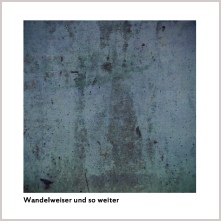Another Timbre TimHarrisonbre
Wandelweiser und so weiter includes new realisations of pieces by well-established figures, such as Michael Pisaro, Jűrg Frey and Antoine Beuger, who has been at the hub of the collective since 1992. There’s welcome exposure for works by younger members, including Sam Sfirri, from South Carolina, and Taylan Susam, from The Netherlands. John Cage and John White are accommodated as precursors, and there are vital contributions from sympathetic outsiders, including London based improvisors Angharad Davies and Phil Durrant, and Annet Németh, a self-taught composer working with “sounds of everyday life and those of a fragile nature”. Each composer brings their own perspective, unexpected instrumental resources – Sfirri’s duet for shortwave radio and melodica is indicative – and imaginatively nuanced structures, yet these six CDs sound aesthetically consistent and thoroughly engrossing.
In a booklet that accompanies the music there’s a discussion between producer Simon Reynell, Beuger, Pisaro, cellist [sic] Dominic Lash and pianist Philip Thomas. They mull over the implications of this creative alliance between Wandelweiser members and practitioners of post-Reductionist improvisation. There’s talk of shared horizons and disparate backgrounds, an expanded range of sonic possibilities with the advent of the improvisors, different approaches to listening and issues of interpretation, the status of the score and the pivotal role played by trombonist Radu Malfatti. The thought-provoking chatter ceases once the music starts. I’m reminded of starlings, voluble when perched, yet in flight virtually silent aside from the flutter of wing-beats and the whirr of their twists and turns. Certainly Wandelweiser music has less in common with effusive birdsong than with the threshold sounds made by bodies in motion.
In the booklet, Pisaro endorses the image of a flock to describe the way these musicians have come together. He also approves of Reynell’s pun on the meaning of sound, finding the image of “a narrow passage of water between the mainland and an island” useful for evoking “the often hard-to-parse internal changes in the music”. Reynell’s wordplay extends to the titles of individual discs: ‘Confluences’, ‘Crosscurrents’, ‘Drifts’, ‘Eddies’, ‘Undertows’ and ‘Upwellings’. As with a flock of birds, forming fabulous and unpredictable shapes within its own limits, this watery language suggests various forms of musical mobility contained within boundaries established by the composers. Whatever else may be said, this is music that moves.”
Julian Cowley, The Wire

The Wire - review of ‘Wandelweiser und so weiter’
“In his essay After Modernism, Morton Feldman suggested that close attention to the work of Mark Rothko could produce “a sensation that we are not looking at the painting, but the painting is looking at us”. Comparably, the quiet, often beautiful music of the loose-knit Wandelweiser collective seems to place attentive listeners under a kind of scrutiny. That may explain why so many reflective words have proliferated around this music; why these composers, whose work is so restrained in character and absorbed with silence, feel the need to supplement it with text. Historical accounts, aesthetic statements and technical descriptions form an extensive gloss to Wandelweiser’s subdued sounds, in printed interviews, websites, notes issued with CDs.